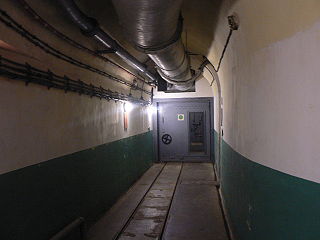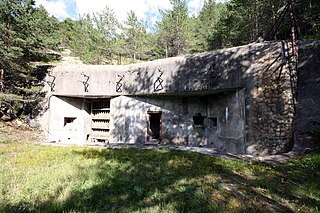Ouvrage Mottenberg is a lesser work of the Maginot Line. Part of the Fortified Sector of Boulay, the ouvrage consists of one entrance block and two infantry blocks, and is located between petits ouvrages Coume Annexe Sud and Kerfent, facing Germany.

Ouvrage Sapey is a work of the Maginot Line's Alpine extension, the Alpine Line, also known as the Little Maginot Line. The ouvrage consists of one entry block, three artillery blocks and one observation block two kilometers west of Modane. The ouvrage was built beneath the older Fort du Sapey. The new work cost 12.8 million francs.

Ouvrage Saint-Gobain is a work of the Maginot Line's Alpine extension, the Alpine Line. The ouvrage consists of one entry block, one infantry block, one artillery block, one observation block and one combination block. Located in Modane, France, it is just across the valley of the Arc from Ouvrage Saint-Antoine and somewhat to the east of Ouvrage Sapey.

Ouvrage Saint-Antoine is a work of the Maginot Line's Alpine extension, the Alpine Line. The ouvrage consists of one entry block, one infantry block and one artillery block overlooking Modane on the way to the Col du Mont Cenis. Ouvrage Saint-Gobain is just to the north, across the mountain valley. Saint-Antoine overlooks the approaches to the Fréjus Rail Tunnel and was part of an ensemble of forts, including Saint-Gobain, Ouvrage Sapey and Fort du Replaton that guarded the French end of the tunnel and the descent from the Mont Cenis pass.

Ouvrage Le Lavoir Is a work of the Maginot Line's Alpine extension, the Alpine Line, also called the Little Maginot Line. The ouvrage consists of two entry blocks, one infantry block, three artillery blocks and one observation block 6 kilometres (3.7 mi) south of Modane, France, guarding the Col de Fréjus. The surface barracks at Le Lavoir were connected to Charmaix by an aerial tram.

Ouvrage Pas du Roc is a work of the Maginot Line's Alpine extension, the Alpine Line. The ouvrage consists of one entry blocks, one infantry block, two artillery blocks and one observation block 6 kilometres (3.7 mi) south of Modane and 1.6 kilometres (0.99 mi) east of Ouvrage Le Lavoir in the vicinity of the Col de Fréjus. The position was incomplete at the outbreak of war in 1940.
Ouvrage Roche-la-Croix is a work of the Maginot Line's Alpine extension, the Alpine Line, also known as the Little Maginot Line. The ouvrage consists of one entry block, two infantry blocks, one artillery block and two observation blocks in the vicinity of the Col de Larche. An aerial tram was provided for better access. The position is located at the top of a sheer escarpment that dominates Meyronnes and the valley of the Ubayette.

Ouvrage Saint Ours Haut is a work of the Maginot Line's Alpine extension, the Alpine Line, also known as the Little Maginot Line. The ouvrage consists of one infantry block, one artillery block, two observation blocks and one combination block in the vicinity of the Col de Larche. It is located on the territory of the commune of Meyronnes. Construction began in March 1931, at a cost of 15.1 million francs.

Ouvrage Restefond is a work of the Maginot Line's Alpine extension, the Alpine Line. The ouvrage consists of one artillery block and three observation blocks at the summit of the Col de la Bonette. The entry block and an artillery block were not completed, and a further block was never built. At 2,733 metres (8,967 ft), Restefond is the highest Maginot ouvrage.
Ouvrage Gordolon is a work of the Maginot Line's Alpine extension, the Alpine Line, also known as the Little Maginot Line. The ouvrage consists of one and two infantry blocks at an altitude of 728 metres (2,388 ft). Gordolon was built by Borie contractors at a cost of 21.4 million francs. Work started in November 1931 and was completed in April 1934.

Ouvrage Flaut is a work of the Maginot Line's Alpine extension, the Alpine Line, also called the Little Maginot Line. The ouvrage consists of one entry block, one infantry block and one artillery block at an altitude of 771 metres (2,530 ft). The position was intended, acting with Ouvrage Gordolon, to stop an approach by Italian forces from the north towards Nice through the Vésibie Valley.

Ouvrage Plan Caval is a lesser work of the Maginot Line's Alpine extension, the Alpine Line, also known as the Little Maginot Line. The ouvrage consists of two infantry blocks and one observation block facing Italy. The ouvrage is located on the heights of L'Authion, surrounded by older fortifications. Three additional blocks were planned to make it a gros ouvrage but were not built. Cost for the full ensemble was estimated at 23 million francs.
Ouvrage Monte Grosso is a work of the Maginot Line's Alpine extension, the Alpine Line, also known as the Little Maginot Line. The ouvrage consists of one entry block, four artillery blocks and two observation blocks facing Italy. It was the largest ouvrage in the Alps It is part of the fortifications surrounding Sospel, which protect the approaches to Nice from the north.

Ouvrage Saint-Roch is a work of the Maginot Line's Alpine extension, the Alpine Line, also known as the Little Maginot Line. Small for a gros ouvrages, the ouvrage consists of one entry block, one artillery block and two observation blocks overlooking Sospel at an altitude of 426 metres (1,398 ft). The position is located just to the southwest of Sospel, its entrance block in a narrow valley and the artillery block on the other side of the ridge overlooking Sospel. The ouvrage is laid out along a single line, with the entry block to the rear, immediately followed by the usine, with barracks farther along and Blocks 2 and 3 at intervals. The position's main armament is concentrated in Block 4, a massive blockhouse designed to protect against rockfalls from higher up the mountain.

Ouvrage Castillon is a work of the Maginot Line's Alpine extension, the Alpine Line, also called the Little Maginot Line. The ouvrage consists of one entry block, two infantry blocks, and two artillery blocks in a narrow ridge just to the west of Castillon, Alpes-Maritimes. It was built on the original site of Castillon, destroyed by an earthquake in 1887. It is the next gros ouvrage in the line to the north of Ouvrage Sainte-Agnès, and is within firing range of the Mediterranean coastline.
Ouvrage Mont Agel is a work of the Maginot Line's Alpine extension, the Alpine Line, also called the Little Maginot Line. The 1930s ouvrage was built in and around the earlier mountaintop Fortress of Mont Agel. The ouvrage forms a backup to the main curtain of Alpine Line forts, and was not initially planned as part of the Alpine Line proper. Its intended function was primarily to provide heavy, long-range artillery support from a location well to the rear of the line. However, the planned 145mm heavy guns were never installed. Its site on Mont Agel, at an altitude of 1,118 metres (3,668 ft), is the highest point in the vicinity of Nice and Menton and commands the entire coastline, as well as the approaches from Sospel to the north. The site is now occupied by Base Aérienne 943 of the French Air Force and functions as an air defense control station.
Ouvrage Roquebrune is a work of the Maginot Line's Alpine extension, the Alpine Line. The ouvrage consists of one entry block, two artillery blocks and one observation block facing Italy. The fortification is located on the heights behind Roquebrune at an elevation of 321 meters overlooking Cap Martin and the bays of Roquebrune and Menton. The ouvrage was manned by 293 men of the 58th Demi-Brigade Alpin de Forteresse (DBAF), supported by the 157th Régiment d'Artillerie de Position (RAP), under the command of Captain Gayot.
Ouvrage Croupe du Réservoir is a lesser work of the Maginot Line's Alpine extension, the Alpine Line. Located on the heights of Roquebrune at an elevation of 139 meters, the ouvrage consists of one entry block and one observation block facing Italy and covering the Grande Corniche road. The fortification was manned by 60 troops of the 58th Demi-Brigade Alpin de Forteresse (DBAF) under the command of sous-lieutenant Roman.
Ouvrage Vélosnes is a gros ouvrage of the Maginot Line, located in the Fortified Sector of Montmédy between the towns of Othe and Vélosnes, facing Belgium. It possesses four combat blocks and one entrance block. It is located to the east of petit ouvrage Thonnelle. The position was sabotaged and abandoned by French forces that were ordered to retreat from the exposed position in June 1940 during the Battle of France. The ouvrage is abandoned and is administered as a nature preserve.

Ouvrage Chesnois, also known as Ouvrage Chênois, is a gros ouvrage of the Maginot Line, located in the Fortified Sector of Montmédy, facing Belgium. The ouvrage lies between the towns of Montlibert and Thonne-le-Thil. It possesses six combat blocks. It is located between gros ouvrage Thonnelle and petit ouvrage La Ferté. The position was sabotaged and abandoned by French forces that were ordered to retreat from the exposed position in June 1940 during the Battle of France. The ouvrage is now abandoned and sealed.















